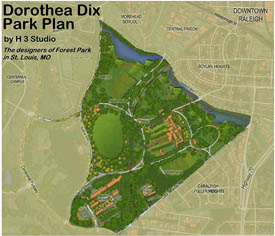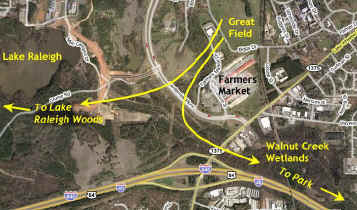Mission Statement
The purpose of the Friends of Dorothea Dix Park is to promote the
establishment and support of a "World Class Destination Park" in North
Carolina's Capital City on the Dorothea Dix campus, saving the existing
open space and preserving the historically significant buildings.



 .gif)


Frequently Asked Questions
Contact Us
Member Organizations & Endorsements
Justification
News Articles
Map Resources
Park Plan Details (including White Paper Finance Plan)
Compare the FDDP Park Plan and the Urban Land Institute (ULI) Development Plan
History
Video
Photos
|
Compare the FDDP Park Plan with the ULI
Development Plan
Dix 306 is a grassroots movement to let our politicians know
that the people they represent overwhelmingly want to preserve all the remaining Dorothea Dix campus as a park.
| |
|
Look at the ULI Development Plan next to the FDDP Park Plan:
|
ULI Development Plan

Click map for detailed land use plan in new windowThe
ULI Development Plan in a Nutshell
"Dix Development & Park Plan"
Joseph Huberman
The ULI Development plan consists of a 248 acre
mixed use development and a 215 acre park on state land.
-
ULI uses all the Dix land, the
Farmers Market and some University land which it trades with the Park for
the Big Field.
-
The City of Raleigh raises $30 million of public money with
tax increment financing (TIF), the citizens raise $10 million from
donations, so the City can buy the property with $40 million.
-
The State
agrees to a lease arrangement to finance its office space and then gives
the $40 million to a Mental Health Trust Fund.
-
The Mayor appoints the (DCDC)
"Dix Campus Development Corporation", from stakeholder groups to
oversee the development.
-
To build 3,400 residential units ULI allots 35
acres to single family homes and l65 acres to townhouses.
-
Then 1.2 million
square feet of office and retail is built on 123 acres.
-
Finally, they
include 25 acres of open space in the development, and housing for the
mentally ill in the park.
Link to the ULI slide show final presentation on October 27,
2006 2.9meg PDF file
|
Friends of Dorothea Dix Park Plan

Click map for full size view in new windowH3 Studio's John Hoal developed The Friends of Dorothea
Dix Park park plan.
Among his credits is the plan for Forest Park in St. Louis.
This plan just contains a broad outline for the park's
development.
-
Rocky Branch flood plain is modified so it has small pools, and the
adjoining land is terraced so that people can be either near the water, or
gaze down upon it.
-
Some of the soccer fields are relocated near the Fuller
Heights neighborhood.
-
The Great Field is ringed with trees.
-
The
Farmers' Market is incorporated into the park.
-
The road on the west
side is smoothed out to create a stronger boundary for the park.
-
There are strong greenway
connections to adjacent neighborhoods, the Convention Center, the downtown
developments, Centennial Campus, Lake Raleigh, and the Walnut Creek
wetlands.
|
Compare each stakeholder's
situation in the two plans
|
| Key
Differences Between The ULI Development Plan and the FDDP Park
Plan
The key land use difference between the
Urban Land Institute (ULI) and Friends of Dorothea Dix Park plan
is where the development occurs and how it affects its
neighbors. In the Friends plan the development is concentrated
around the edges of the park. This benefits the existing
residential and commercial neighborhoods adjacent to the park
and distributes the development opportunities to many land
owners and developers.
On the other hand, the ULI plan concentrates all
the development to a few developers on the state owned property.
The ULI development separates the park from Lake Wheeler Road
and creates a barrier to the redevelopment of these
neighborhoods by offering new construction on state owned land
that will overwhelm the market in the surrounding neighborhoods
stalling their renewal for years.
If the "sense" of the park flows through the
Farmers' Market, then Dix Park will merge into Centennial
Campus, Lake Raleigh and the new Walnut Creek Park adding much
more green space to explore. It is this synergy between the 306
acre Dix Park, the University, and the City Park that extends
the Dix property so that it can become a World Class Destination
Park gaining regional significance for the enjoyment of
residents and visitors as well as a vital economic engine for
the region and the state.
If we default to the ULI plan that restricts the
park to 200 acres adjacent to a 250 acre development for 9,000
residents and 20,000 employees it will demote the park from a
"World Class Destination Park" to a "Very Nice Community Park",
which while fine for the people buying into the new neighborhood
and working at the new offices, will do little to attract the
amenities that make a park "World Class". It won't be a
"Destination". Without the "Destination" attractions the region
stands to loose hundreds of millions of dollars a year in new
tourist revenue. But worse yet, we will loose our last
opportunity to have a grand "Central Park". We will be cutting
out our heart-- for what? Another in an endless row of housing
developments and shopping centers.

|
|






